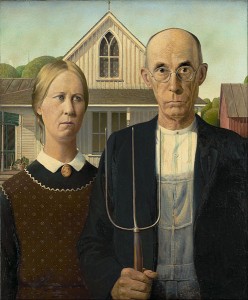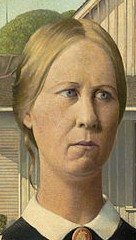Cén stíl agus cén chuma? (What style and what appearance?) Posted by róislín on Feb 28, 2014 in Irish Language
(le Róislín)
B’fhéidir gurb í seo ceann de na fuinneoga is clúití i stair ealaíne. An aithníonn tú í? Bhí sí sa phictiúr a bhí sa bhlag is déanaí (https://blogs.transparent.com/irish/cad-a-dheanfaidh-tu-ar-an-deireadh-seachtaine-seo-what-are-you-doing-this-wee/). Cén stíl í?
Perhaps this is one of the most famous windows in the history of art. Do you recognize it? It was in the picture that was in the most recent blog (link above). What style is it?
Is é “Carpenter Gothic” an t-ainm atá ar an stíl seo d’ailtireacht. Ní bhfuair mé frása beacht Gaeilge air sin in áit ar bith ach “Gotach” atá ar “Gothic” agus tá trí fhocal, ar a laghad, ar “carpenter.” “Saor adhmaid” is coitianta i mo thaithí féin, ach tá “siúinéir” (joiner) agus “cearpantóir” ann freisin.
Tá nasc don phictiúr thíos / There’s a link to the picture below.
This style of architecture is called “Carpenter Gothic.” I haven’t found an exact Irish phrase for it but “Gotach” is “Gothic” and there are at least three words for “carpenter.” “Saor adhmaid” is the most widely used in my experience but there are also the terms “siúinéir” (joiner) and “cearpantóir.”
Tá tionchar an Ghotachais agus tionchar na hAthbheochana Gotaí ar an stíl seo. Féach cé chomh rinneach is atá áirse na fuinneoige! Ach tá sé i bhfad níos simplí ná samplaí clasaiceacha de stíl Ghotach agus den Athbheochan Ghotach, Ardeaglais Reims (1211-1275) agus Halla Baile Mhanchain (1877), mar shamplaí (ní gá a rá). Agus mar is soiléir ó ainm na stíle bíonn foirgnimh “Carpenter Gothic” déanta as adhmad, ní as clocha mar atá na hardeaglaisí Gotacha agus na foirgnimh Ghotacha.
The Gothic and Gothic Revival styles have influenced this style. See how pointed the window arch is! But, needless to say, it is much simpler than the classic examples of Gothic and Gothic Revival styles, such as Reims Cathedral (1211-1275) and Manchester Town Hall (1877). And as is clear from the name of the style, “Carpenter Gothic” is made of wood, not from stone like the Gothic cathedrals and buildings.
Maidir leis na daoine, cén chuma atá orthu? Seo cuid de na haidiachtaí a dhéanann cur síos orthu, déarfainn. An féidir leat cur leis an liosta? Agus an féidir leat iad a mheaitseáil leis an mBéarla atá sa bhanc focal? Tá an banc focal faoin liosta.
As for the people, what is their appearance? (lit. what appearance is on them?). Here are some of the adjectives that describe them. Can you add to the list? And can you match them with the English that’s in the word bank? The word bank is below the list.
Just to add to the “dúshlán” [doo-hlawn], the word bank has 11 English words for the 10 in Irish. Two of the English words can apply to one of the Irish words.
1. dúr
2. fulangach
3. cinniúnaíoch
4. síonbhuailte
5. stóch
6. tostach
agus go fisiciúil
7. an-tanaí
8. fadaithe
9. scrogallach
10. scailleagánta
BANC FOCAL (aon fhocal déag anseo): dour, elongated, fatalistic, grim, lanky, long-necked, resigned, stoic, taciturn, very thin, weather-beaten
Tá an bheirt beagnach mar dhá phríomhphainéal na fuinneoige (ard, tanaí, rinneach) agus an píce eatarthu mar rannadóir phánaí na fuinneoige. Beirt atá ceaptha i bhfrithchaitheamh a n-eisidh mar a bheadh gaiste ann, an ea? Bhuel, sin nóisean teibí na seachtaine, is dócha! An méid a bhí i gceist ag an ealaíontóir Grant Wood? Nó an róanailís atá ann? Do bharúil?

‘Gotach Meiriceánach’ B’fhéidir gur macalla den phíce é an rannadóir pána san fhuinneog. Agus tá na haghaidheanna beagnach chomh rinneach le háirse na fuinneoige. Do bharúil?
The two people are almost like the two main panels in the window (tall, thin, pointed) with the pitchfork between them like the windowpane divider (aka the “muntin,” but I can’t find a more specific Irish equivalent for that!). Two people who are caught in the reflection of their existence as if it were a trap? Well, that’s the abstract notion of the week, I guess! Was that much on the mind of the artist, Grant Wood? Or is that an over-analysis? Your thoughts?
Hmm, tá ábhar machnaimh eile ann. Fuinneoga clúiteacha nó radhairc i scannáin, mar shampla, ina bhfuil fuinneog feiceálach? Fuinneoga Chartres nó a mhalairt d’fhuinneoga .i. na fuinneoga beaga cruinne atá ar thithe na hobad sa “tSír” sa scannán The Hobbit? Agus sibhse, cad a shíleann sibhse? An bhfuil aon fhuinneog i scannán nó i litríocht a ritheann leat mar shiombail nó mar gheall ar áille na fuinneoige féin (an gréas, an gloine, srl.)?
Hmm, it’s food for more thought. Famous windows or movie scenes, for example, in which a window is prominent? The windows of Chartres or the opposite type of window, that is, the small round windows on the hobbit houses in the Shire in the movie The Hobbit? And you, what do you think? Is there a window in a movie or in literature that comes to mind as a symbol or because of the beauty of the window itself (the design, the glass, etc.)?
Bhuel, pé scéal é, sin beagán cúlra den phictiúr “American Gothic” agus cur síos beag air. Meas tú gur bhog an bheirt ó thosaigh muid a bheith ag caint fúthu? Foluainín fabhra, b’fhéidir? Nó casadh beag na n-ordóg nach bhfuil sa phictiúr? Ní dóigh liom é. Iad sin a chuir an focal “stóchas” san fhoclóir, sílim! SGF — Róislín
Freagraí: 1. dúr, dour, grim; 2. fulangach, resolute; 3. cinniúnaíoch, fatalistic; 4. síonbhuailte, weather-beaten; 5. stóch, stoic; 6. tostach, taciturn; 7. an-tanaí, very thin; 8. fadaithe, elongated; 9. scrogallach, long-necked; 10. scailleagánta, lanky. Nóta faoi na focail seo: As an ngrúpa focal seo, ní déarfainn go n-úsáidtear go coitianta an-mhórchuid acu, go mór mór i mbuntéacsanna. Chloisfí “an-tanaí” go minic go leor, cinnte, agus b’fhéidir “tostach” agus “dúr.” Maidir leis na cinn eile, déarfainn gur focail cineál liteartha nó an-tuairisciúil iad, an-mhaith do chásanna áirithe ach gan a bheith i mórán gnáthchomhráite laethúla. Note about these words: Out of this group of words I wouldn’t say that most of them are used all that commonly, especially in basic texts. “An-tanaí” would be heard often enough, certainly, and perhaps “tostach” and “dúr.” Regarding the others, I’d say they are kind of literary or very descriptive, very good for certain purposes but not in many ordinary daily conversations.
So to wrap that up, some of the 10 vocabulary words are fairly ordinary, but others I probably wouldn’t use in Irish any more often than I’d probably use their English counterparts. But when they fit the figurative bill, they hit the figurative nail right on the head. Isn’t “scrogallach” a nice pithy and concise way to describe “duine a bhfuil muineál tanaí scáinte aige/aici.”
Nasc don phictiúr: http://en.wikipedia.org/wiki/File:Grant_Wood_-_American_Gothic_-_Google_Art_Project.jpg#filelinks

Build vocabulary, practice pronunciation, and more with Transparent Language Online. Available anytime, anywhere, on any device.







Leave a comment: